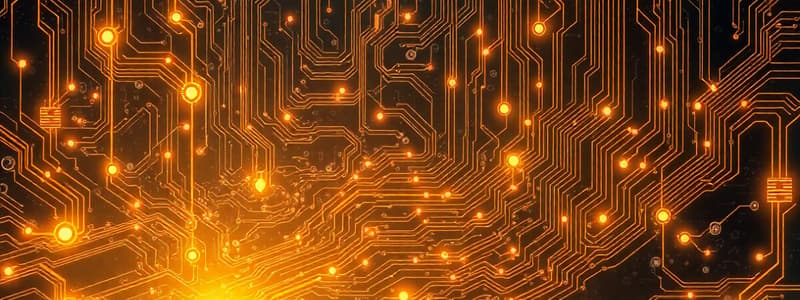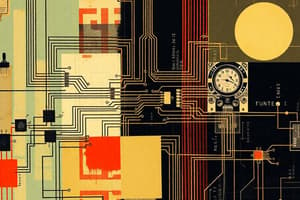Podcast
Questions and Answers
What is the primary function of diodes in electronic devices?
What is the primary function of diodes in electronic devices?
- To amplify signals
- To allow current flow in one direction (correct)
- To limit current flow
- To store electric charge
Which of the following is a characteristic of operational amplifiers?
Which of the following is a characteristic of operational amplifiers?
- Require external power to operate
- Only function in digital circuits
- High input impedance and low output impedance (correct)
- Low input impedance and high output impedance
Under Ohm's Law, which equation correctly represents the relationship between voltage, current, and resistance?
Under Ohm's Law, which equation correctly represents the relationship between voltage, current, and resistance?
- R = V / I
- I = R / V
- V = I + R
- V = I × R (correct)
In a series circuit, what can be said about the current flowing through each component?
In a series circuit, what can be said about the current flowing through each component?
What does Kirchhoff's Current Law state?
What does Kirchhoff's Current Law state?
What is the purpose of capacitors in electronic devices?
What is the purpose of capacitors in electronic devices?
Which theorem simplifies a complex circuit to a single current source and parallel resistance?
Which theorem simplifies a complex circuit to a single current source and parallel resistance?
What application makes use of signal processing techniques?
What application makes use of signal processing techniques?
Flashcards are hidden until you start studying
Study Notes
Electronic Devices
-
Definition: Electronic devices manipulate electricity to perform specific functions.
-
Types:
- Passive Devices: Do not require external power; examples include resistors, capacitors, and inductors.
- Active Devices: Require external power; examples include diodes, transistors, and integrated circuits.
-
Key Components:
- Diodes: Allow current to flow in one direction; used for rectification.
- Transistors: Function as switches or amplifiers; types include BJT (Bipolar Junction Transistor) and FET (Field Effect Transistor).
- Operational Amplifiers: Used in signal processing; characterized by high input impedance and low output impedance.
Circuits
-
Definition: A circuit is a closed loop that allows current to flow and perform work.
-
Types:
- Series Circuits: Components connected end-to-end; same current flows through all components.
- Parallel Circuits: Components connected across the same voltage source; different components can carry different currents.
-
Basic Laws:
- Ohm's Law: V = I × R (Voltage = Current × Resistance).
- Kirchhoff's Laws:
- Current Law: The total current entering a junction equals the total current leaving.
- Voltage Law: The sum of the electrical potential differences around any closed circuit is zero.
-
Components:
- Resistors: Limit current flow; measured in Ohms (Ω).
- Capacitors: Store electric charge and energy; measured in Farads (F).
- Inductors: Store energy in a magnetic field when electric current flows through; measured in Henrys (H).
Circuit Analysis Techniques
- Nodal Analysis: Uses Kirchhoff's current law to determine voltage levels at circuit nodes.
- Mesh Analysis: Uses Kirchhoff's voltage law to determine current flow in each loop of a circuit.
- Thevenin's Theorem: Simplifies a complex circuit with a single voltage source and series resistance.
- Norton’s Theorem: Simplifies a complex circuit with a single current source and parallel resistance.
Applications
- Power Supplies: Convert AC to DC; includes transformers and rectifiers.
- Signal Processing: Amplification, filtering, and modulation of signals; uses op-amps and filters.
- Digital Electronics: Logic gates, microcontrollers, and microprocessors used for computation and control.
- Communication Systems: Transceivers, antennas, and modulation techniques for transmitting and receiving information.
Safety and Testing
-
Safety Precautions:
- Always disconnect power before working on circuits.
- Use insulated tools and wear personal protective equipment.
- Be aware of the ratings for current and voltage to avoid overloads.
-
Testing Equipment:
- Multimeter: Measures voltage, current, and resistance.
- Oscilloscope: Visualizes electrical signals over time.
- Signal Generators: Produce various electrical waveforms for testing.
Summary
Understanding electronic devices and circuits is fundamental for diagnosing, designing, and implementing a variety of electronic systems. Knowledge of components, circuit laws, analysis techniques, and practical applications is crucial for effective electronic engineering.
Electronic Devices
- Manipulate electricity to perform tasks.
- Passive Devices: Don't need external power (resistors, capacitors, inductors).
- Active Devices: Require external power (diodes, transistors, integrated circuits).
- Diodes: Allow current in one direction, used in rectification.
- Transistors: Act as amplifiers or switches, types include BJT and FET.
- Operational Amplifiers: Used in signal processing, have high input impedance and low output impedance.
Circuits
- Closed loops allowing current to flow and do work.
- Series Circuits: Components connected in a line, same current flows through all.
- Parallel Circuits: Components connected across the same voltage source, different currents can flow through each.
- Ohm's Law: Relates voltage, current, and resistance: V = I × R.
- Kirchhoff's Laws:
- Current Law: Total current into a junction equals the total current out.
- Voltage Law: Sum of voltage differences around any closed loop is zero.
- Resistors: Limit current flow, measured in ohms (Ω).
- Capacitors: Store electrical charge and energy, measured in farads (F).
- Inductors: Store energy in a magnetic field when current flows, measured in Henrys (H).
Circuit Analysis Techniques
- Nodal Analysis: Uses Kirchhoff's Current Law to find voltage at nodes in a circuit.
- Mesh Analysis: Uses Kirchhoff's Voltage Law to find current flow in each loop of a circuit.
- Thevenin's Theorem: Simplifies a complex circuit into a single voltage source and series resistor.
- Norton's Theorem: Simplifies a complex circuit into a single current source and parallel resistor.
Applications
- Power Supplies: Convert AC to DC, using transformers and rectifiers.
- Signal Processing: Amplify, filter, and modulate signals, uses op-amps and filters.
- Digital Electronics: Logic gates, microcontrollers, and microprocessors for computation and control.
- Communication Systems: Transceivers, antennas, and modulation techniques to send and receive information.
Safety and Testing
- Safety Precautions:
- Always disconnect power before working on circuits.
- Use insulated tools and personal protective equipment (PPE).
- Be aware of current and voltage ratings to avoid overloading circuits.
- Testing Equipment:
- Multimeter: Measures voltage, current, and resistance.
- Oscilloscope: Visualizes electrical signals over time.
- Signal Generators: Produce various electrical waveforms for testing.
Studying That Suits You
Use AI to generate personalized quizzes and flashcards to suit your learning preferences.




